I ventured off to the chandlers with the vague hope of finding a thin nut to screw onto a charging point on one of the torches.
"Sorry, we only supply branded products here, but you could try the engineering workshop over there where the large crane is," was the best I could get.
I marched off to this establishment, but after a deal of searching they admitted they did not stock anything so small. I explained all this to Rex, and we agreed it would be best left until we returned to the UK.
We slipped our lines and headed to the fuel pontoon; ouch!, Euros 2.70/litre. A tank full should see us all the way back to the UK with fuel to spare. The young lad who helped us had ample supplies of tissues to ensure not a drop went overboard.
Without ceremony, we parted company and shot off down to the sluis to gain access to the Mast Gat. The only excitement was watching a Rijkswater vessel pulling up a channel buoy, blasting the mud off the chain with a power washer as it did so. That's what we need on Duonita I thought.
We followed a very circuitous route, skirting a fish farm and entered via Sluis Goese Sas into the canal to Goes. Sharp eyed Rex spotted a swimmer in the canal, who was not towing a floating buoy to betray his presence.
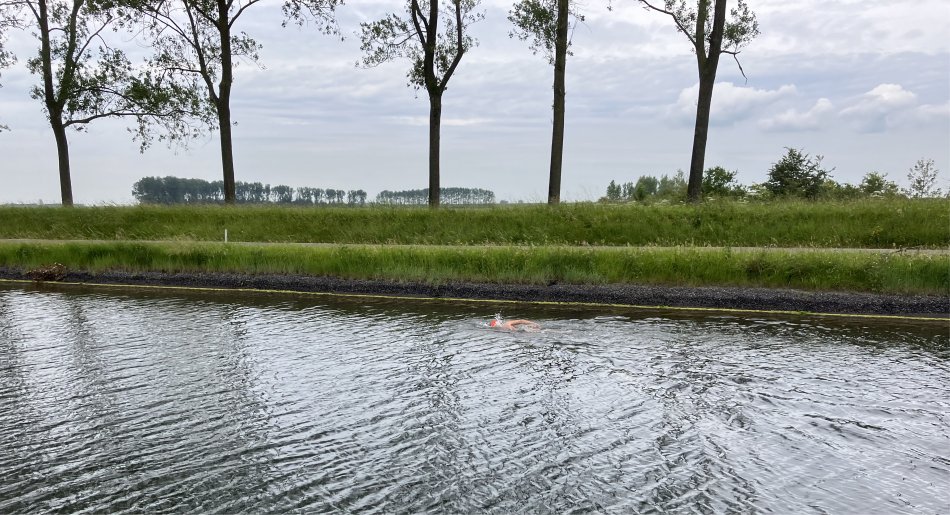 Beware of Canal Swimmers |
"Yes, we are," we replied.
"Are you going through the Sint Maartenbrug as well?"
"No, we are just going to the jachthaven "de Werf"."
"That is OK. There is just your boat?"
"Yes."
"I will open the bridge shortly." He cycled off to the bridge. Things didn't quite go to plan. When he hoped to open the bridge, there was a traffic jam strewn across it. By the time that cleared, we spotted a small motor boat and a large yacht sprinting to catch the opening. Fortunately, he kept it open for them.
Just after we passed through the open bridge, we spotted a young fellow standing on the side of the canal. "You are coming into the marina?" he enquired.
"Yes, we intend to," was our response.
"OK, take box 5 on the left as you enter."
We duly found it, and due to its large size (the box was designed to take two boats), we managed to get our stern ropes across to vertical poles to the rear of the box. I discovered the young chap who directed us was also the harbour master.
A volunteer, who had spent the day cutting grass in the marina grounds, stopped and chatted for a while. He was ultra keen to inform us about carillon performances in town starting at 19:30. I in turn fed his passion by relating the carillon performances we had heard recently at Dordrecht and Antwerp. He was ecstatic.
"Oh, we have had a major change," he added. "The beer in our clubhouse next to the harbour master's office has increased in price to 75 cents for a 300ml bottle," he winked, and headed off to continue his work.
Staying in this beautiful marina was almost like camping; trees and lushnesss evrywhere you looked. Rex and I put the world to rights for a while in what was now a glorious, sunny day. The sun must have been too powerful for Rex, he donned his purple shorts and purple shirt. Purple Ronnie strikes again.
Then, while Rex had a nap, due perhaps to the effect the colour purple has on him, I decided to hike into town. I got as far as the pretty Sint Maartenbrug. St. Maarten or Dark Gate stood on the junction of Goeskade and Kleine Kade (Goes and Little Quays) until 1853. On the other side of the basin was the Oostere Poort (East Gate). Around 1970 talks took place concerned with the filling in of the basin for a car park. Common-sense prevailed, and instead St. Maartenbrug was erected, allowing water craft to enter the basin for mooring purposes.
By the bridge I discovered an art gallery, Galerie Goese Kade, just past the bridge. Naturally I entered
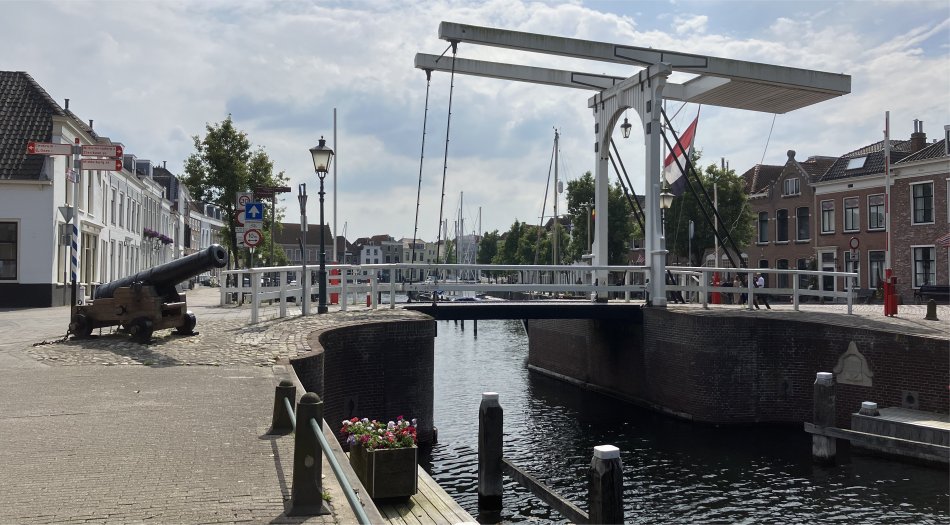 Sint Maartenbrug |
"Are you the owner?" I asked.
"Yes, I am Ron Westerweel," he replied.
"Oh, sorry, am I allowed to look around?"
"Of course you can. The impressionist paintings in that room were painted by a guest artist. The rest are mine."
We chatted, and I could not help but notice he had a large patch of bandages over his left ear. He sensed my curiosity, and said, "I had an operation on my ear today, but it is OK. I had skin cancer around my ear, but it has gone now."
We chatted about cancer for a while, and I encouraged him to stay positive. "That is 90% of the battle. My wife had cancer, and she was very strong and stayed positive," I said, trying to bolster his spirits.
"Your wife had cancer," he said, but pursued the matter no further.
He was keen to find out how an Englishman came to be here. I explained the two of us had sailed over in a boat. He used to sail himself, but not anymore. He then proceeded to show me one of his paintings of a regatta featuring a tall ship, skiffs and other craft. His treatment of the water and sky created a lot of movement in the painting, and he had tried to use the movement to suck the viewer into the painting.
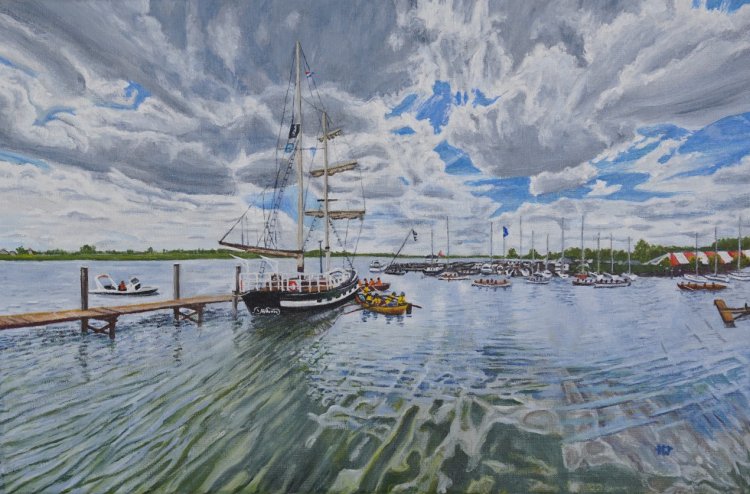 |
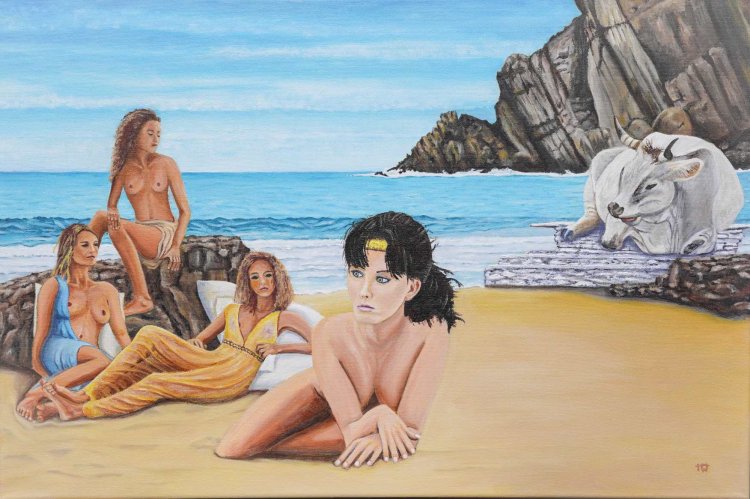 |
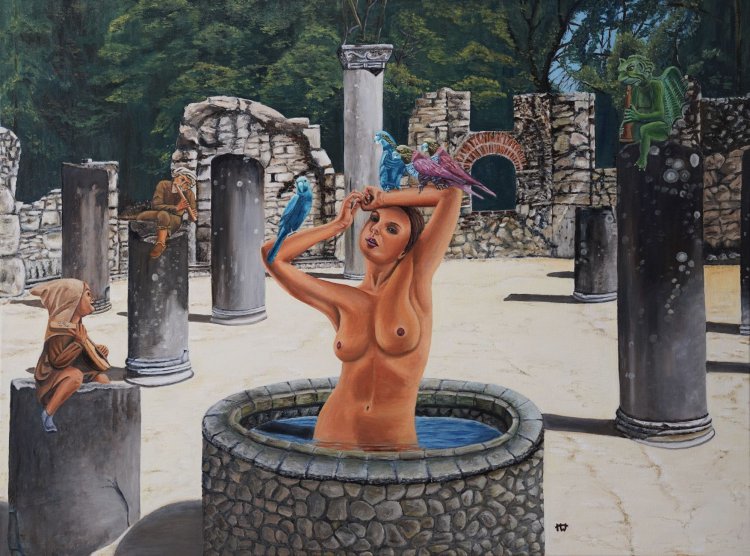 Paintings by Ron Westerweel |
He showed me more of his paintings, in which he tried to portray his interpretation of legends.
One of the legends he picked up on arose when he considered where did Europe come from. The story of Europa and Cadmus is found in Greek mythology. They were the children of the king of a land called Phoenicia, which is modern day Lebanon. The God Zeus fell in love with Europa and wanted to take her away from her family to live with him. One day while Europa was wandering amongst her fatherís herds of cattle she saw a white bull. She was not aware that Zeus had turned himself into the bull in order to trick her. After she climbed on his back he quickly jumped into the sea and carried her away from her homeland. Europaís father was heartbroken and sent her brother Cadmus to find her and bring her home. Cadmus sailed over the sea and eventually arrived in Greece. He never did find his sister but it was Cadmus who brought the alphabet to the Greeks. The continent of Europe got its name from the princess Europa.
Another legend concerned a beautiful Albanian woman, but sadly the embellishments were so complicated I cannot recall the tale.
"Do you exhibit your paintings, or display them on the internet, or perhaps both?" I asked with genuine curiosity.
"I exhibit in Holland, and have exhibited in the USA," he informed me, "plus two of my paintings went to the Hilton in London. I also have a website."
I learned he used to be a doctor, but now he was retired, he has focussed more on his art. He didn't need the money, so he could now paint what he wanted. "Just like Manet," I quipped. He wanted to go back to London to exhibit. He enjoyed London, and in doing so, he could take his wife who had never been there before.
We discussed the relative merits of Brexit, but he stated that Holland could not afford to step out of Europe since it is such a small country. On the subject of the big players such as USA, Russia and China, he was quick to point out that the Russian economy is only on a par with say Italy.
Eventually the parting of our ways came, with me wishing him good luck with his art, and he wished me good luck on my journey.
I began my quick hike into this historic town in earnest. In the 10th century, on the edge of a river, de Korte Gos (the Short Gos), a small settlement was created; Goes. The village grew rapidly and in the early 12th century it boasted a market square and a church devoted to Maria. In the 13th century Goes grew into a port town and the town acquired more and more rights. City rights were granted in 1405, and Count William VI gave the town permission to administer justice in serious crimes, a process that sealed the shift from village to town. In 1417 Countess Jacoba of Bavaria gave the town permission to build walls and gates around the town. Seafaring, cloth making and especially the production of salt were principal means of livelihood in the 15th century. During this period the town continued to grow despite the uncertain political situation, wars, floods and crop failures. However, the connection to the sea gradually degraded, and during the 16th century Goes declined. A large fire in 1544 destroyed a part of the city with a quarter of the wooden houses being burnt down. The town's population at that time was around 1,750.
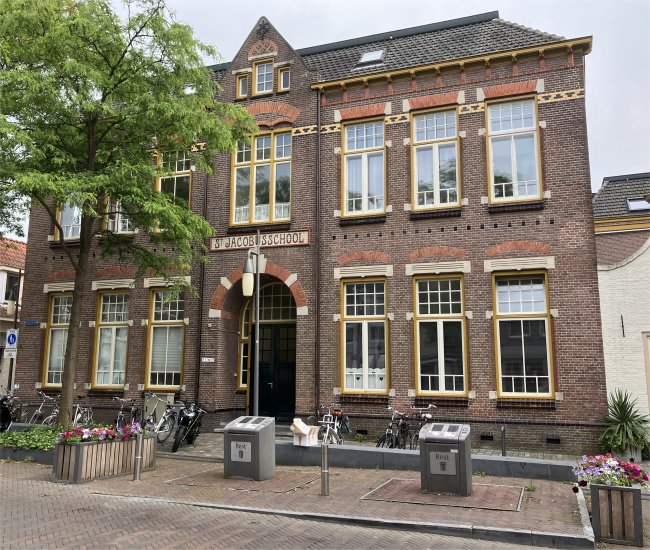 St. Jacobusschool |
The streets I was walking around were hardly different from those in the 16th century. However, the buildings and houses in the course of the centuries changed regularly.
Walking further into the town I entered what had been known as the Oude Beestenmarkt (Old Cattle Market), being renamed as the Vlasmarkt (Flax Market) in 1580. A noble looking building dominated this square. In the 16th century, a large mansion stood here, 't Huys van Lodijk. In 1881 it was bought by the Roman Catholic Church, and converted in 1905 into a convent for school girls. This school was demolished in 1913 and replaced by the new St. Jacobusschool. It has served as a residential property since 1986.
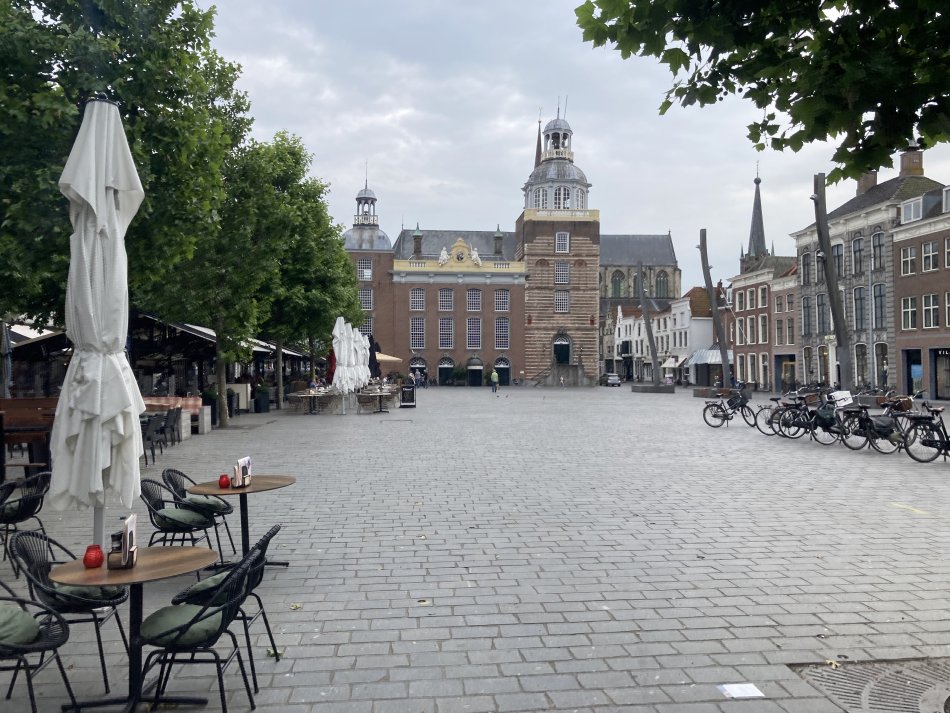 Grote Markt with Stadhuis in Front of the Grote Kerk of Maria Magdalenakerk |
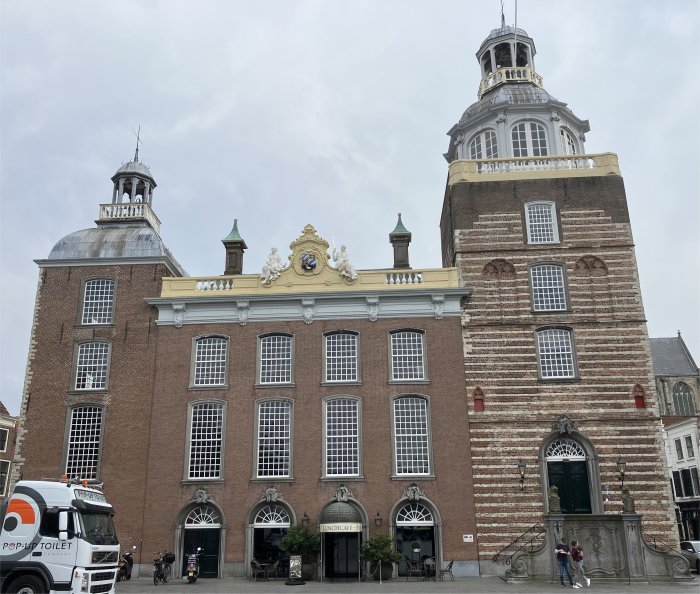 Stadhuis |
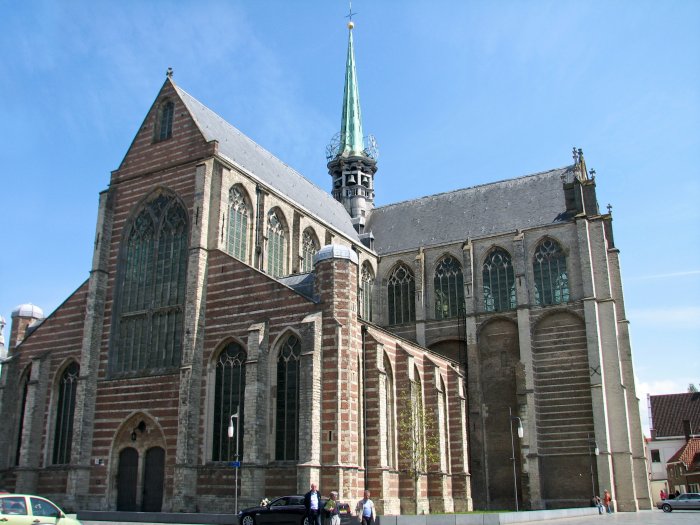 Grote Kerk of Maria Magdalenakerk |
Sandwiched between the Grote Markt and Grote Kerk of Maria Magdalenakerk stood the Stadhuis (Town Hall). Late Gothic and Rococo in style, the oldest part was the right tower (1389), which served as a prison, the "vanghuus". In addition, there was a market hall where the weighing-balance stood. Above this stood a hall, furnished like a tribunal where justice was meted out, and where the city council met. Behind the market hall were the meat market and stalls for rent. An orphan room and a city messenger house were built in 1463. The upper floor of the town hall was still used for receptions and weddings.
On the eastern side of the pedestrianised area stood the Grote Kerk of Maria Magdelenakerk, a dominant, colossal building in the heart of the town. The history of this building goes back to the 12th century when a small Catholic church room was built at this location. This room was expanded to the East several times. In 1455 a major reconstruction and extensions started, that were finalised in 1520. In 1578 the building was taken over by Reformed church. It was rebuilt, mainly in stone, after 1618, when a fire was started by the carelessness of a slater. The tower was erected during the rebuilding of the church.
An historic building, the Weeshuis (orphanage), stood on Singelstraat. This 15th century building was part of the housing of the Black Sisters, an order of nuns. The sisters devoted themselves to nursing. In 1627 the monastery was in use as an orphanage. Between 1620 and 1795 the former convent chapel served as a Walloon church, offering shelter to the soldiers. From 1821 until shortly before World War II, the chapel served as an orphan's school. In 1970, the Historical Museum Bevelanden was established here. Behind the Weeshuis lay a beautiful small courtyard, the Weeshuisplein, reached by passing under an arch next to Weeshuis.
The Manhuis complex stood next to the Weeshuis. For a long time, the Manhuis was established in an annex to the monastery of the Black Sisters. In 1655 they founded a new building and in 1689 provided a private entrance to the new Manhuis, a gate decorated with two stone statues. Between 1741 and 1787 the Manhuis acted as a host, a military hospital and barracks. It continued until 1962 as an old "singing" house. In recent times, the owners, the municipality of Goes, have been trying to get rid of it. The Dutch too feel the economic squeeze.
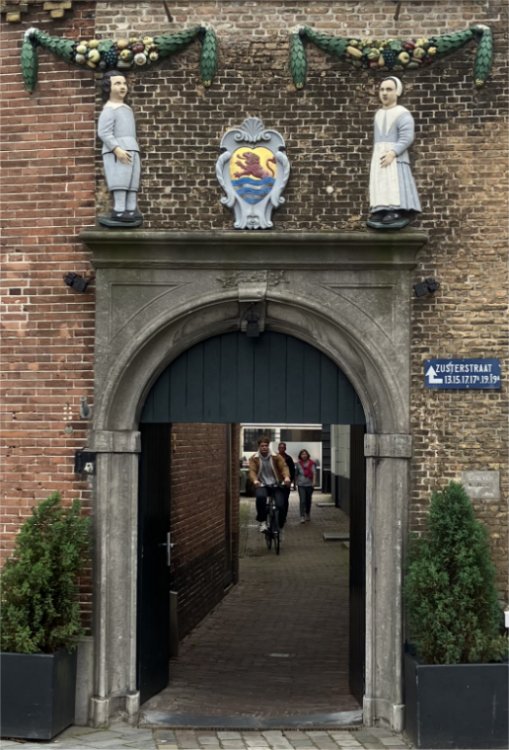 Gate Leading to the Weeshuisplein |
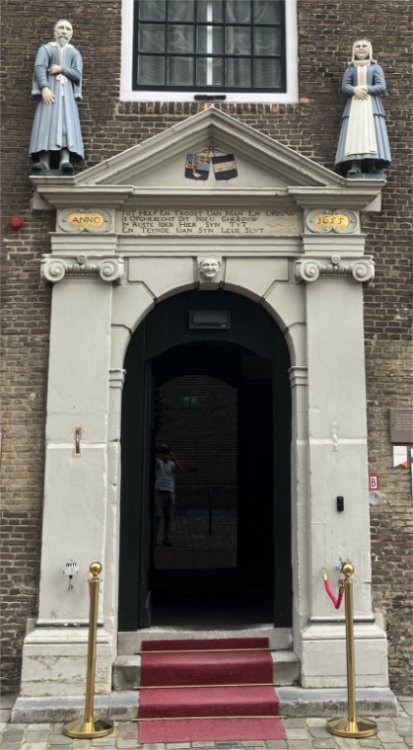 Gate into the Manhuis |
The small open area on the Turfkade first bore the name "New Fish Market", and later became known as the Visperk. The small octagonal building replaced an earlier one in 1647 when the fish stalls were no longer required. It was used as a place where fish was sorted and distributed to the fish market.
The top of the Turfkade was headed by Kleine Kade 47, a grand building in the Lodewijk XIV style, topped by two towers. In actual fact it was built around 1765 by joining two premises. The house on the left is from the 16th century. The front is from the former hotel, "The Korenbeurs".
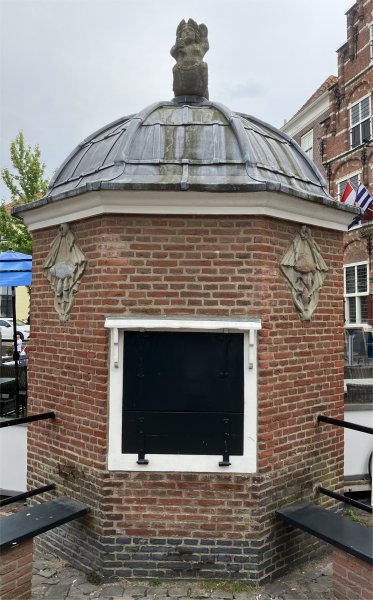 Visperk |
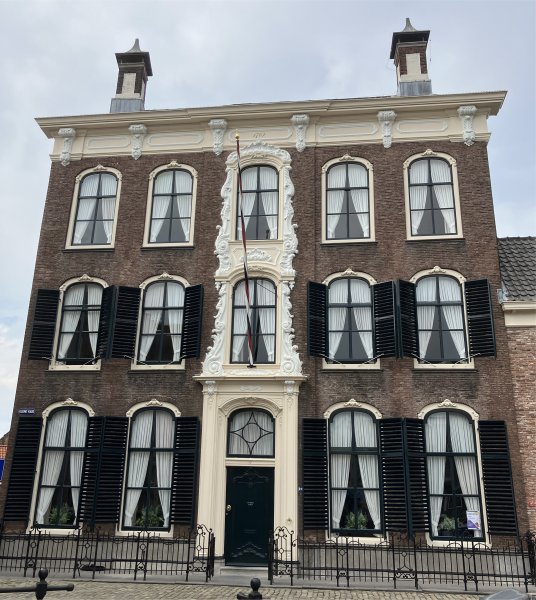 Kleine Kade 47 |
In the evening, Rex and I visited a drinking man's pub to watch the first half of the England versus Denmark Euro 2024 match. We then dined in the Grote Markt, overlooked by the impressive Stadhuis, and melodies from the carillon performance streamed from the Grote Kerk of Maria Magdalenakerk behind it. It was a warm, sunny evening, very tranquil until the occasional trainee clown tore through the square on a motorbike, or his boy racer car. Rex was not amused. I could hear him muttering, "Nelson never had this trouble."
We returned to Duonita more than satisfied with the day, and decided to walk along the marina side to the main canal. "Dave!" I heard Rex shout, expecting to turn round to find his camera in my face. On turning round, I was confronted by a giant of a man, who I subsequently found to be 2.1m tall. We exchanged a few expressions of awe, and off he bounded to his boat moored on the canal side.
